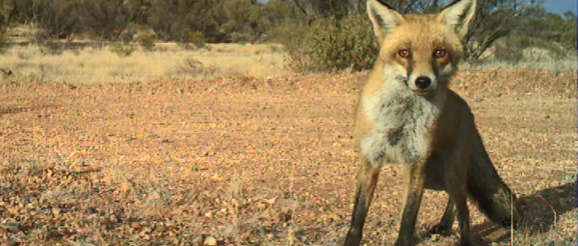Fox baiting innovation keeps native species, even working dogs, far from the poison targeting pest – ABC Rural – ABC News

A simple homemade innovation is directing foxes to poisoned bait while preventing dingoes and other wildlife from being poisoned.
key points foxy
Key points:
Canid pest ejectors, which shoot poison into the mouths of canines when they pull at a bait, have not been used in some parts of Australia because of the threat they pose to dingoes.
But a homemade metal ‘collar’ attached to the device has been shown to allow access by foxes, while preventing dingoes and other native wildlife from triggering the poison.
A dingo tries to access the bait, but the simple collar does not suit its head shape.
Supplied: DENR
Dr Lauren Young, a scientist with the Northern Territory’s Department of Environment and Natural Resources (DENR), said the design was based on the different-shaped heads of the dingo and fox.
“It’s a rectangular metal collar that the pest ejector sits inside,” she said.
“The idea is that it’s too narrow for a dingo to get its nose in to access the bait head and pull. But foxes, their noses are much narrower than a dingo’s, so they can get their nose inside and grab the bait head and pull on it.”
DENR ran trials of the collar at two central Australian locations, Watarrka National Park and Owen Springs Reserve, from September 2017 to April 2018.
Dr Young’s team used motion-sensitive cameras near the canid ejectors to monitor the activity of a range of species around the devices — which were not fitted with poison capsules for the trial.
After a small modification to the collar, they found that foxes were able to access the bait head but dingoes were not.
Dr Young believes the collars could allow fox baiting programs to go ahead in central Australia.
Supplied: DENR
‘Euphoric’ moment for inventor
Dr Glenn Edwards, DENR’s director of wildlife use and pest animals, invented the collar and made 50 of the devices to be used in the trial.
He said it was a “euphoric” moment when he saw the device working in the field.
“It was what we’d wanted to see. It was proof of concept and confirmed that we were on the right track,” he said.
“We potentially have a useful tool — dare I say a groundbreaking tool — which will allow us to advance the management of foxes in the NT.”
Dr Edwards said the collar could also be useful for pastoralists.
As introduced pests, foxes wreak havoc on many different populations of endangered species.
Flickr: Jans Canon
“I think this device will have applications in the conservation area … [and] I also think it will potentially have applications in the production sector where farmers are wanting to manage foxes,” he said.
“Foxes have an impact on sheep and lambs so farmers are interested in managing those impacts.
“[Farmers] also have working dogs which they need to protect, so I think this device will have some utility in that area as well.”
Foxes a huge threat in arid zone
Dr Edwards said foxes were a big threat to native species in central Australia, despite many people not knowing they even inhabited the arid zone.
“There’s probably a lack of appreciation for the presence of foxes in the southern NT, and the reason for that is that foxes are very cryptic,” he said.
“You rarely see them. What you see more often is fox tracks, but fox tracks look very much like dog tracks or dingo tracks. You’ve got to have your eye in to pick the difference.”
Dr Edwards said foxes potentially posed an even greater threat to native species than the more-publicised threat of feral cats.
On the frontline of the fight against urban foxes
“My personal view is that foxes historically have probably caused more problems and made a bigger contribution to the extinction of particularly our native mammals than what cats have,” he said.
“Foxes go in for surplus killing, so they have more capacity to wreak havoc with a small population of an endangered species.
“They will kill more animals than they need to eat … and cats tend not to do that.”
Plenty showed up for trial
Dr Young said the footage they gathered throughout the trial showed off the biodiversity of the central Australian arid zone with birds, reptiles and mammals all captured around the test sites.
The metal collar aims to protect dingoes and other native animals from accessing the baithead that triggers the canid pest ejectors’ poison.
ABC News, file photo
“We’ve had almost 80 different species, that includes eight or 10 introduced species. But the rest of them were native,” she said.
“I think that’s an incredible record for the park rangers to have out there. It’s good to see that many native species showing up at those sites.”
Dr Young said the biodiversity of arid areas was only set to improve once the collared poison delivery device was rolled out in areas that foxes were known to inhabit.
“For this device we’re currently thinking the potential is around [helping] species we still have here — black-footed rock wallabies, bilbies, great desert skinks, plains mice,” she said.
“Going forward you could start thinking more about the broader-scale options of translocation, but that’s probably a way off.”
The DENR team now hopes to roll out the fox management program in areas where there are concentrations of threatened species.
It also hopes to do trials in areas where other native animals cohabitate with foxes to ensure they cannot access the bait.
